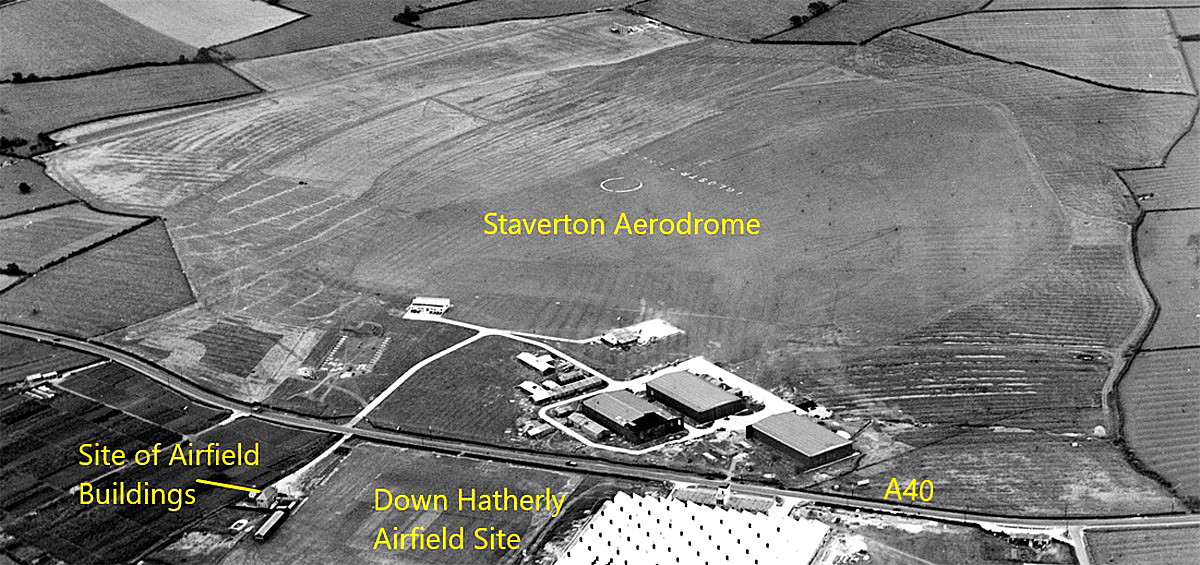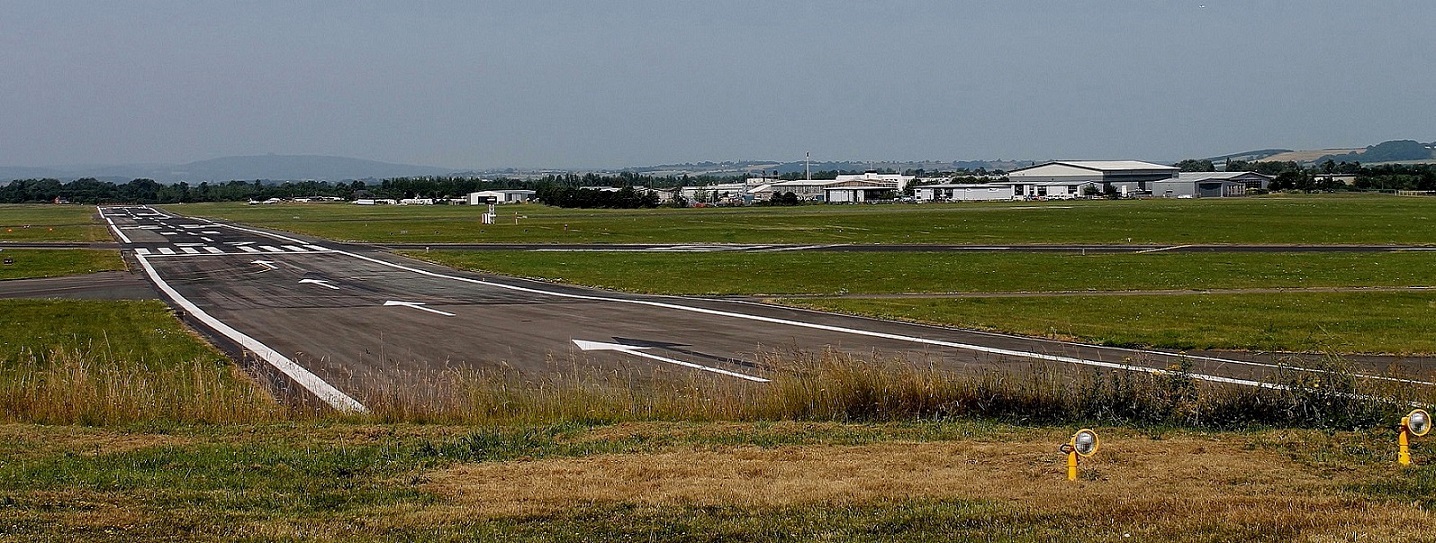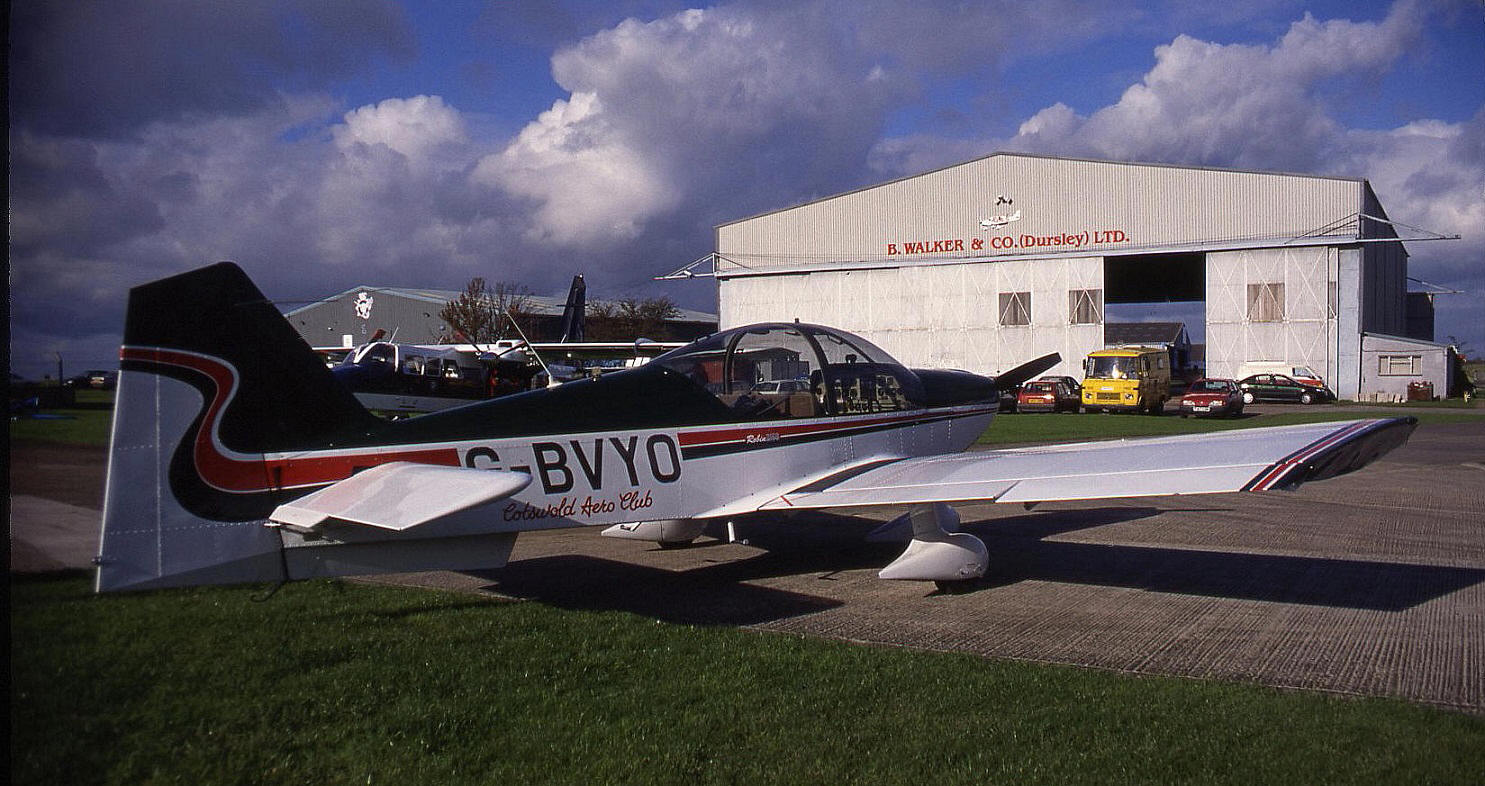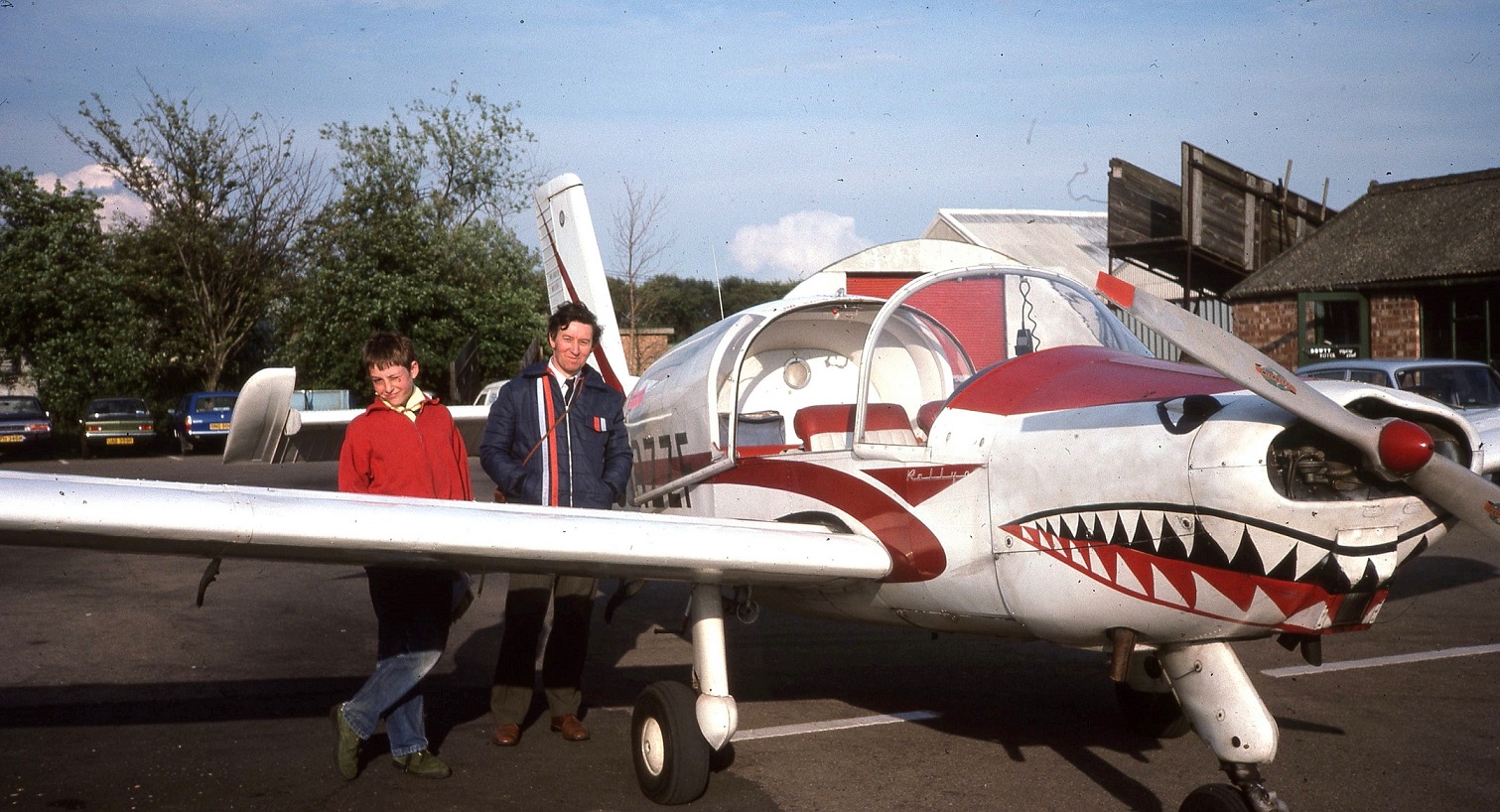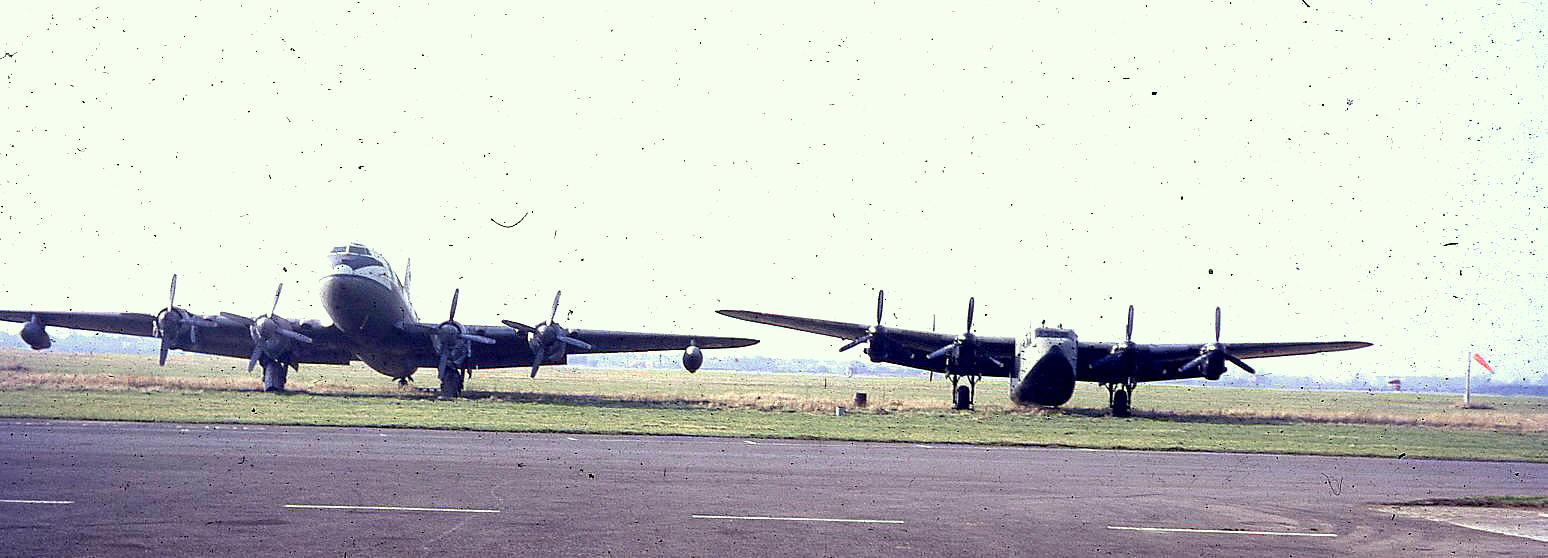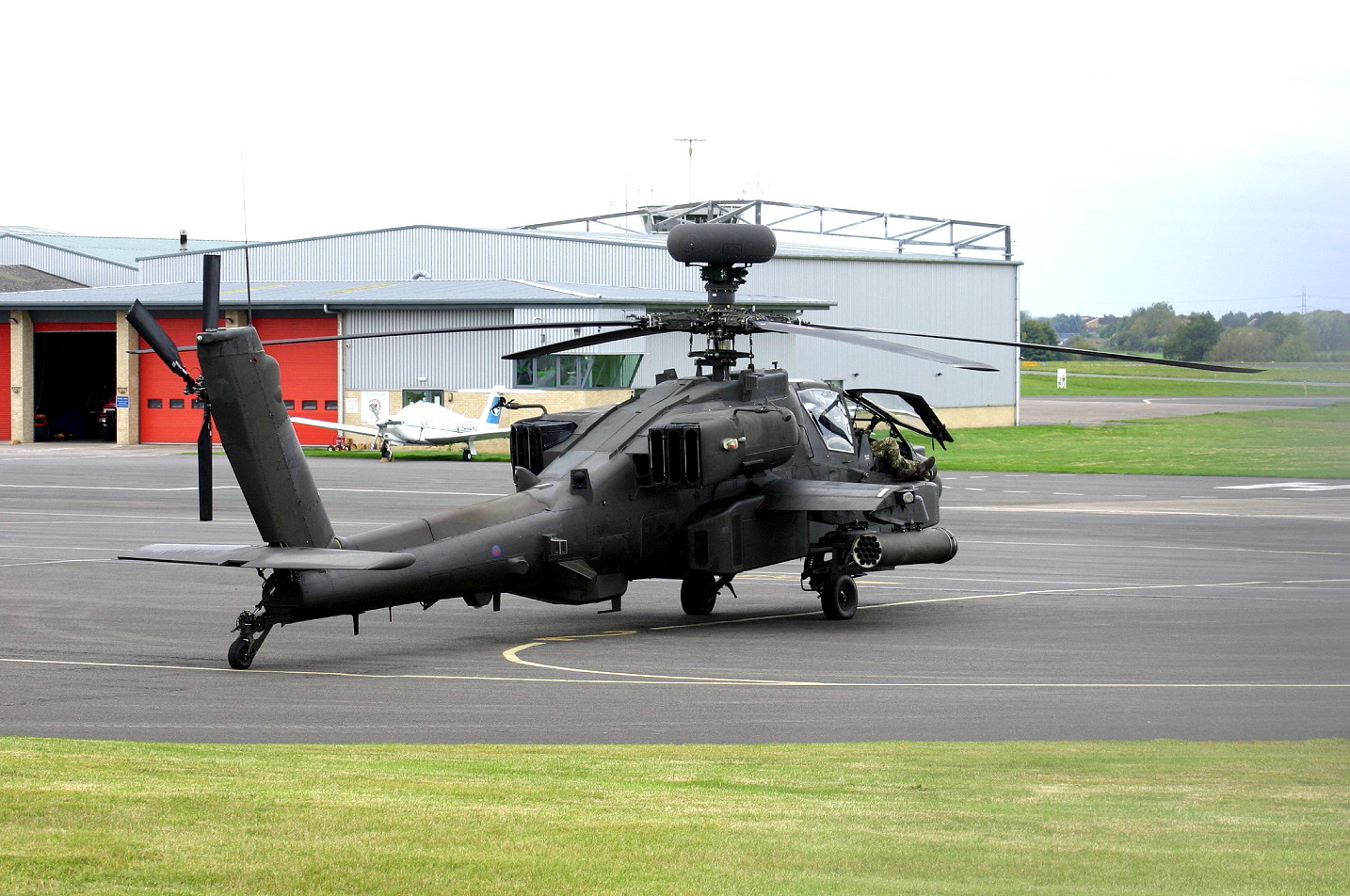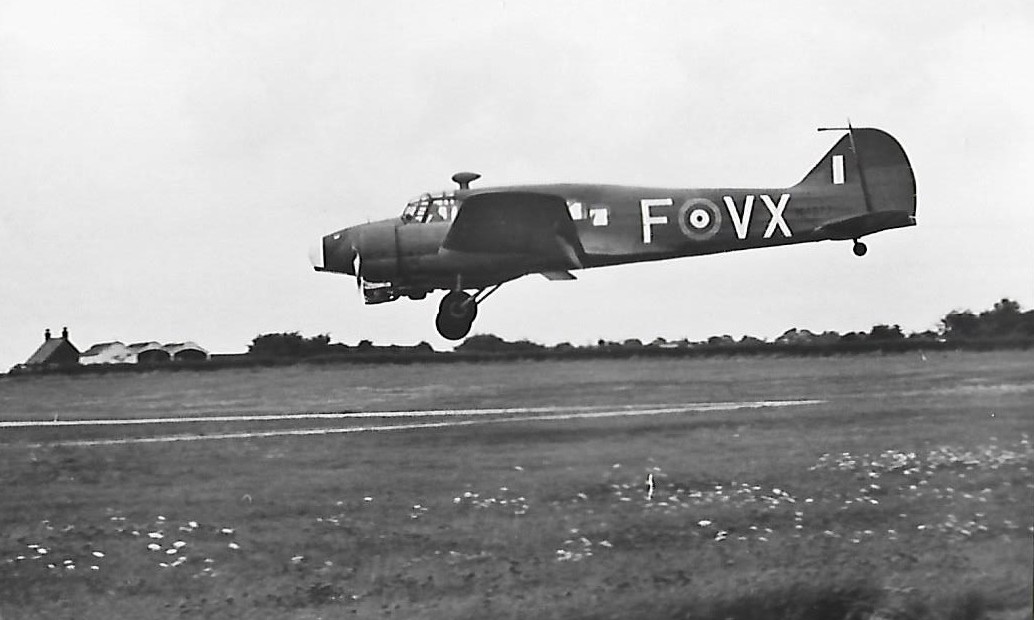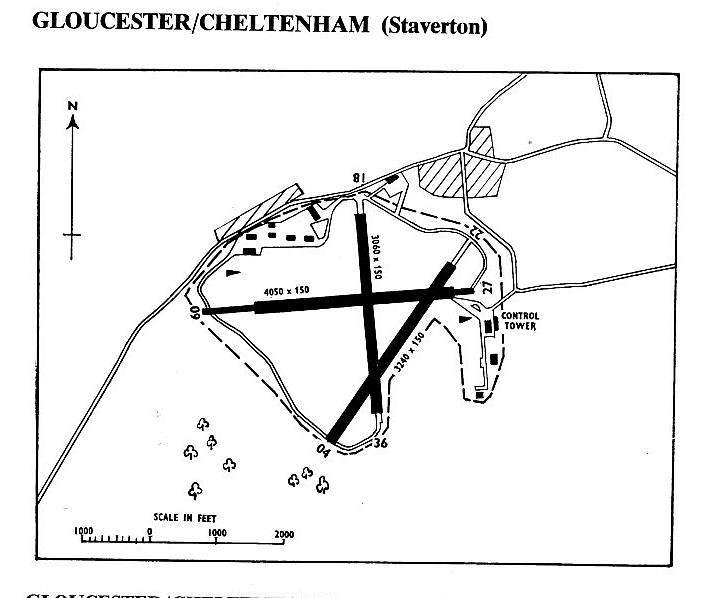Gloucestershire Airport
GLOUCESTERSHIRE AIRPORT: Civil regional airport, military in WW2, later regional airport again.
Note: The aerial photo was kindly sent by Mr Michael T Holder. The second picture was obtained from Google Earth ©
(Previously very well known as STAVERTON)
(2001 known as GLOUCESTERSHIRE AIRPORT, in 1990 also known as GLOUCESTER/CHELTENHAM)
Note: All pictures by the author unless specified.
Note: I cannot remember where the small and rather poor picture of Derby Airways Canadair Argonaut came from. However, it does now appear that this was the largest airliner to land here.
ICAO code: EGBJ IATA code: GLO
Operated by: From 1953 Cambrian Air Services later Smiths Industries in 1957
1965: Gloucester/Cheltenham Joint Corporations
1980s/1990s: Gloucester/Cheltenham Joint Airport Committee
2000: Gloucestershire Airport Ltd
Military user: WW2: RAF Flying Training Command 25 Group 6 AFU (Avro Ansons)
Activities: Post 1945: Regional airline, GA charter/air taxi, rotary, private, training and maintenance
Manufacturing: Dowty/Rotol, Smiths Industries (Including Smiths Instruments’ Flying Unit)
Note: These pictures from postcards were kindly sent by Mike Charlton who has an amazing collection. See; www.aviationpostcard.co.uk
First picture: The de Havilland DH60G Gipsy Moth G-ABER was first registered on the 5th September 1930. It was operated by The Cotswold Aero Club from the 1st February 1935 until the 16th January 1940, being impressed into the RAF on the 13th February 1940 as W7946.
The Desoutter 1 G-AAPU was, I assume, a visitor? First registered on the 14th December 1929, I can only find a record of it being based at DUXFORD from the 8th July 1938. It appears it was WFU (Withdrawn From Use) at CAMBRIDGE in August 1939.
Second picture: If anybody can kindly put a date to this picture, this advice will be most welcome.
British airline users: Pre 1945: Railway Air Services
Post 1945: Air Corbiere, Aurigny Air Services, Cambrian Air Services, Derby Airways, Intra Airways, Manx2, Murray Chown
Charter/air taxi: Pre 1940: Western Aviation
Post 1945: Bardock Aviation, Bristol Air Taxis
Flying schools and Clubs:
Pre 1940: Cheltenham Aviation?
Post 1945: Aeros Flying Club, Aviator Flying Club, Cotswold Aero Club, Gloucester Aero Club, Gloucestershire Aviation Centre, Gloucester Flying Club, Gloucester & Cheltenham School of Flying, Rotol Flying Club, SkyTime Flight Training, Staverton Flying School, Westflight Aviation
In the 1957 The Aeroplane directory, the Cheltenham Aero Club were operating: One Auster J/1 Autocrat, one Auster J/5 Aiglet Trainer and one Miles M.38 Messenger.
In the same directory the Cotswold Aero Club were listed as operating: One Auster, one Miles M.17 Monarch and one DH89A Tiger Moth.
Plus, in this same directory, the Gloucestershire Aviation Centre were offering; "Full flying school facilities and ground school for private pilots' and commercial pilots' licences and radio operators' licenses; instrument rating and instructors' certificates. But, they gave no indication of the aircraft types being operated. Can anybody kindly offer advice?
And, in addition, the Rotol Flying Club are listed as operating one Auster Alpha, presumably a J/1N example?
Also, last but certainly not least, was the Smith's Flying Club, affiliated to the Cotswold Aero Club. This of course was the flying club for Smith's Industries, a very large, powerful and influental concern in British aviation in those days. Their fleet it seems was: One Auster, one Miles M.17 Monarch and one DH82A Tiger Moth. It therefore seems obvious that the Smiths Flying Club were in fact, flying the Cotswold Aero Club aircraft, and had none of their own.
1959 ‘snapshot’: Cheltenham Aero Club, Cotswold Aero Club, Rotol Flying Club
SOME EXTRA INFORMATION
In July 2022 I was kindly contacted by Mr John Putley whose father was heavily involved with the Rotol Flying Club, later renamed the Dowty-Rotol Flying Club. He confirms that their first aircraft was indeed an Auster J/1N Alpha - G-AHCL. From what I can make out 'Charlie Lima' was operated by the Club from 04.04.56 until 25.07.73, and possibly until 26.07.77?
In the early 70s the Club acquired the Morane-Saulnier MS-880 Rallye Club G-AZZF. It appears, but once again I cannot be certain, that the Dowty-Rotol Flying Club operated this aircraft from 12.02.73 until 06.01.83. Indeed, John tells us he started his flying lessons with 'Zulu Foxtrot'. The reason I am a tad doubtful about the exact dates is because in those days registration details were entered in handwriting - and not always easily legible.
A JOHN PUTLEY GALLERY
Note: The first picture shows Zulu Foxtrot before the 'sharks teeth' motif was added.
Note: The Miles M38 Messenger 2A G-AKBN was registered to the Middlesex Flying Group from 18.07.66 to 19.06.73. How it ended up here appears unknown, but it was declared PWFU (Permanently Withdrawn From Use) in March 1975.
Note: John took these pictures of the Scottish Aviation Twin Pioneer Series 3, G-BBVF, in 1974 as it was taxying out to runway 09/27. Flight One Ltd operated it here from 17.12.73 to 19.05.83. It was declared PWFU (Permanently Withdrawn From Use) on 08.08.83. A remarkable STOL type, it only required an unprepared area of 275x30 metres to operate from.
Note: The Handley Page HP67 Hastings served mainly with RAF Transport Command from 1948 until 1964 and was a replacement for the Avro 685 York, a type which became very well known with civilian operators, examples flying on freight charter operations from the U.K. to many destinations around the world.
The example in the pictures above, is the Handley Page HP67 Hastings C.1A, TG528 (pictures taken c.1973/74) which was retired from the RAF in Jan 1968 when it went to the Skyfame Museum at STAVERTON. (As this airport was then known). It went to the Imperial War Museum at DUXFORD for restoration in April 1979. It is still there on display.
QUITE A STORY
As is quite undertandable I suppose, the general situation of aircraft allocation at the end of WW2, was quite often chaotic. Built at the Avro factory at YEADON, it was assigned to the RAF in October 1945, painted in RAF colours with the serial TS798 - despite being registered to BOAC (British Overseas Airways Corporation) as G-AGNV - two months earlier on 20.08.45. Once the cock-up had been resolved it was delivered to BOAC at CROYDON on 08.11.45 still wearing its RAF colours and serial.
It served with BOAC until 30.03.55 before being sold to Skyways, also at HEATHROW, where it served until 09.10.64 - being declared PWFU 07.05.65. This aircraft, it seems, has the distinction of having made the last flight by an Avro York, on the 9th October 1964, when it was flown from HEATHROW to STAVERTON - apparently landing at RAF COLERNE whilst en route. The reason being that the York was joined by two RAF Hastings which acted as escorts for the final leg, the York making three flypasts before landing.
Arriving at STAVERTON it joined the Skyfame Museum to be repainted as LV633 "Ascalon", a V.I.P. transport used by Winston Churchill and King George VI during the later years of WW2. It then went to the RAF Museum at COSFORD in January 1976 where it was restored as the RAF transport MW100. Still there on display in 2022.
Note: Bringing us more up to date, John took this picture of the AgustaWestland WAH-64 Apache, ZJ225, when it made a visit here in 2017.
Helicopter ops: Heliflight (UK), Specialist Aviation Services
Notes: The McDonnell Douglas MD900 Explorer, G-WPAS, as pictured here in October 1998, was it appears being operated by Specialist Aviation Services for air ambulance and police duties for the County of Wiltshire. Presumably, and unusually, not reliant on public subscriptions?
Maintenance: Aeros Engineering
Museums: Skyfame
Notes: These two pictures from postcards of working Skyfame exhibits were also kindly sent by Mike Charlton.
The history of the Skyfame museum, which existed from 1965 to 1978, and founded by Peter Thomas in memory of his brother who served in the RAF; and it appears the very first museum in the UK entirely devoted to aviation with flying examples, is well worth looking up. What a fabulous endeavour this was, and such a shame it had to close. This was of course in the days long before sponsorship, government regional legacy and Lottery funding became available.
Regarding the Avro Anson N4877, this was clearly airworthy, and it seems the last example to be so in those days? The Fairey Firefly, having no visible serial, was perhaps used for taxy demonstrations. I have yet to find the serial for this example.
THE JET AGE MUSEUM
Originally founded at BROCKWORTH in 1986, it was forced to close in 2000. However, it appears it has been reformed here since August 2013.
Location: N of A40, W of M5 motorway, NE of Churchdown, 3.5nm W of Cheltenham
Period of operation: 1919 to present day (some sources say it opened in 1936 but was this for military use?)
Note: These maps are reproduced with the kind permission of Pooleys Flight Equipment Ltd. Copyright Robert Pooley 2014
Runways: Originally ‘all over’ grass field (?)
WW2: 03/21 914x46 hard 09/27 914x46 hard 17/35 914x46 hard
1965: 04/22 988x46 hard 09/27 1234x46 hard 18/36 930x46 hard
Note: 09/27 was reduced in width at the western end.
1990: 04/22 972x41 hard 09/27 1421x37 hard
2000: 04/22 972x41 hard 09/27 1421x37 hard
18/36 800x18 hard
In 2006 a grass runway: 04/22 304x19 was licensed
NOTES:
FLYING CIRCUS VENUE
Venue (4th May 1933) for Alan Cobham’s No.2 Tour of the UK
MURRAY CHOWN ETC
Of special interest to me at least was the Murray Chown “airline” based here in the early 1950s at least. During 1950/51 they operated a Percival Proctor on a STAVERTON- “NEWQUAY” (PERRANPORTH) – GUERSEY SERVICE. It appears Murray Chown Aviation only operated from 1949 to 1952 - presumably based at STAVERTON?
In the early 1950s the Gloucester Flying Club operated the Miles Magister G-AJDR but the Club closed through lack of support and the Magister sold to a local scrap dealer. The story of how this aircraft, (the fuselage at least), was ‘rescued’ is told in Tails Of The Fifties compiled by Peter Campbell. This became a series of books which are a ‘must read’ for anybody with an interest in this astonishing period of British aviation histor
RUNWAYS
In many cases regarding WW2 airfields the original runways still exist and STAVERTON is a good example. However, very often not all the original runways are in use and indeed very often not all the surface areas have been retained and licensed for use. The area licensed for use is marked out usually quite clearly - until landing towards a setting sun on a wet runway for example when it can be a devil to see. At some places landing outside the marked area can have quite severe consequences and serious damage to the aircraft can be caused by potholes etc. Even when taxying care is often needed as broken bitumen or concrete surfaces can cause serious damage, especially to propellers and jet engines sucking up debris when power is applied.
In fairness I’m certain this doesn’t apply at STAVERTON who keep the unlicensed runway areas in good repair. I have landed here several times and can’t recall any problems in this regard. Due to it’s size though, and this applies at many of the bigger regional airports, trying to figure out where the taxiways are can be a bit of a problem at times after landing in a light aircraft for the first time. This problem can even affect commercial crews sitting much higher up when first landing at HEATHROW for example. When Pan Am and TWA went out of business and American and United started flying in, one crew made a mistake when taxying and the ground controller gave the crew a right royal rollocking, to which the laid back skipper replied; "Errr, was I once married to you?" Or so the story goes.
AIRLINE OPERATIONS
In the 1950s Cambrian Air Services had been operating DH Herons for scheduled summer services serving the Channel Islands. When financial problems forced Cambrian to withdraw Derby Airways stepped in, the first service commencing on the 8th April 1959. Mostly they used Miles Marathons with their Dakotas filling in when required. As pointed out elsewhere the UK authorities were so paranoid about the huge threat to the UK mainland posed by the Channel Islands (a threat which I have yet to identify) flights from STAVERTON had to land at HURN (Bournemouth) for Customs clearance.
It is a common misconception that the Channel Islands, and the Isle of Man for that matter, are part of the United Kingdom. This is not the case it seems although they do have a certain amount of allegiance to the U.K. but operate as separate entities. A situation that is highly convenient, especially to the rich and famous and arms dealers etc needless to say – serving as tax havens. And, at the same time in those days, viewed by so many as being an ideal honeymoon destination. Hence the term ‘Guns and Roses’ perhaps?
On the 1st May 1963 Derby Airways flew their Canadair Argonaut G-ALHS into STAVERTON for a charter flight to Amsterdam, claimed to be the largest aircraft ever to land here. Derby Airways were hoping that this flight would prove the Argonaut could be used here for scheduled flights but the Air Ministry decided that reverse thrust on landing could not be used to calculate the landing distance required. This said it appears British Midland Airways (which Derby Airways became) operated Viscounts into Staverton (replacing their DC-3s) until 1969. It now appears that the last flight by BMA with a Viscount actually took place on the 19th September 1970. Having recently visited STAVERTON in 2012, and upon seeing the undulating main runway, I much admire any pilots prepared to land a Viscount here. As the next step in services required BAC 1-11s, for which needed the main runway had to be lengthened, (which wasn’t an option due to the cost understandably), these BMA services ceased.
LOCAL COUNCIL AND LOCAL GOVERNMENT ATTITUDES
I find it very interesting to research the attitudes of County Councils in the UK over many decades as to how they view the investment required to have an airport facility. It would appear that support from central government is both patchy and unreliable – no long term commitments available etc. This has of course been a trend which has plagued the U.K. since WW2.
As it turns out, the lack of development at STAVERTON wasn’t of much importance. With Birmingham (ELMDON), Bristol (LULSGATE) and Cardiff (RHOOSE) in relatively close proximity, perhaps STAVERTON never stood much of a chance? When British Midland ceased operations STAVERTON declined as a regional airport. It has always struggled to become one anyway and indeed, even today, remains a minor facility with at times small feeder liner types operating services at certain periods. However, STAVERTON in recent years has become a very lively (and apparently properous?) regional GA facility.
A QUESTION?
In April 1964 is was announced that the ex Derby Aero Surveys Avro Anson 1, G-AMDA, had been restored into it’s original RAF colour scheme as N4877 VX-F and was operating from the Skyfame Museum at STAVERTON. But, was it being used to carry passengers?
MANUEL QUEIROZ
On the morning of the 28th February 2006 Manuel Queiroz took off in a Vans RV-6 for a round-the-world flight, which he completed successfully. His autobiography is Chasing the Morning Sun.
A NEW ERA PERHAPS?
It appears that Manx2 airline operations commenced here in 2008 (?) with connecting flights to JERSEY, RONALDSWAY and BELFAST CITY. Probably BLACKPOOL, LEEDS-BRADFORD and NEWCASTLE as well? Would I be correct in thinking this was the first serious airline operation with an extended network to operate from here since Derby Airways in 1963? It seems worth pointing out that the Dornier Do.228 types operated by Manx2 in 2012 have 19 seats whereas the DC-3s operated by Derby Airways could, possibly, have had seating for up the 32 passengers.
I have long thought that far more use of regional airports throughout Europe is called for and should be combined with a fully integrated transport system giving people the best choice of options with which to travel to their destinations. And by "fully intergrated" I do mean by any combination of rail, road, sea or air. In the last two decades, since the 1990s anyway, it is nice to see this happening more and more.
STAVERTON/GLOUCESTERSHIRE AIRPORT PICTURES
On a personal note Aussie Brown and I landed here on our quest to produce two books about UK airports for Ian Allan in the autumn of 1992, flying most of the time in the Cessna 172 G-WACL from Wycombe Air Centre.
A PERSONAL NOTE AND MORE PICTURES
My first visit by air was as a passenger (sometimes flying the aircraft) in G-LIGG a Cessna 182. I suspect this was in 1991 but I didn't bother to record the flight in my log book. Apart from the visit in 1992, (mentioned above), another visit I certainly do remember was on the 5th of November 1998 when Aussie Brown and I flew down from WYCOMBE AIR PARK in the Cessna 172 G-WACL to conduct an air-to-air shoot for FLYER magazine of the Robin ATL F-GFOR. Aussie asked me if I would be kind enough to take the right-hand seat in the ATL. The sortie was to formate on another Cessna 172 that Aussie had hired, and in effect he'd 'ambushed me'.
A rather severe westerly weather front had passed through leaving very turbulent conditions and it was soon clear that the owner of F-GFOR, having had no previous experience of close formation flying, was never going to get near enough to the 'camera-plane' to get the pictures Aussie needed. So I offered to take-over which the owner was very happy to agree to. This was, to say the least, an interesting exercise. Flying a totally unknown type for the first time, from the right-hand seat, attempting close formation in turbulent conditions. What interested me was the effect of turbulence between the two types, the ATL having a much lower wing-loading than the 172. When getting close a gust would propel the ATL very quickly into a close proximity, quite probably with a collision, with the 172. Obviously some very quick adjustments of the controls were required with power and pitch mainly.
A PROBLEM WE COULD NOT SOLVE
The next day, when departing for WYCOMBE AIR PARK, we found on the pre-departure power checks we had a problem. Because of the long taxy we suspected plug fouling had occurred but the usually tried and tested method of leaning the mixture at high revs failed to clear the problem. So help by an engineer was needed.
MORE PERSONAL MEMORIES AND PICTURES
Apart from landing here I have also visited in my truck when transporting aircraft.
ray bunnage
This comment was written on: 2019-10-13 14:51:33I am currently researching the airfields of Gloucestershire for an interactive display at the Jet Age Museum, Staverton and found your site most interesting. I note that you have not listed RAF Down Ampney, an airfield set up for the D Day landings. Only active for 3 years but an interesting history.
Dick Flute
This comment was written on: 2019-10-13 20:00:10Hi Ray, I think you'll find I do have Down Ampney listed - and have done for some years. Best regards, Dick
We'd love to hear from you, so please scroll down to leave a comment!
Leave a comment ...
Copyright (c) UK Airfield Guide














